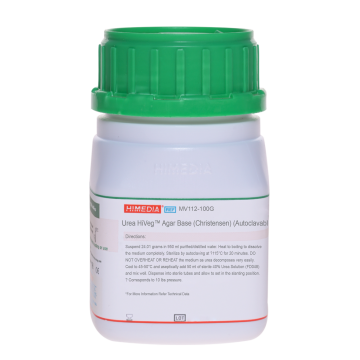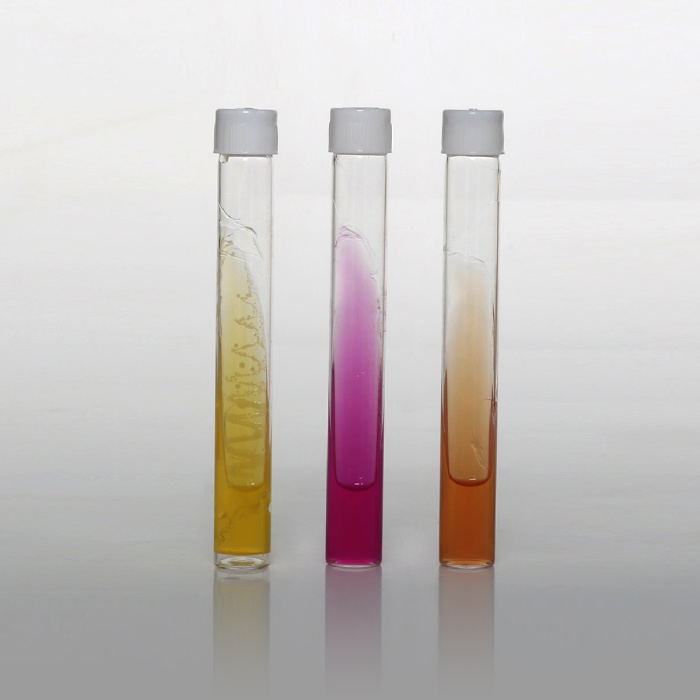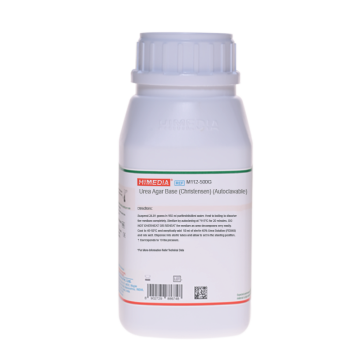 Your enquiry has been submitted
Your enquiry has been submitted
Urea Agar Base, Christensen
Intended Use
Recommended for the detection of urease production, particularly by members of the genus Proteus. The composition and performance criteria are in accordance with ISO 6579-1 :2017.
Composition
As per ISO 6579-1:2017
| Ingredients | g/L |
|---|---|
| Peptone | 1.000 |
| Dextrose (Glucose) | 1.000 |
| Sodium chloride | 5.000 |
| Potassium dihydrogen phosphate | 2.000 |
| Phenol red | 0.012 |
| Agar | 15.000 |
| 50ml U40 Supplement (5 ml per vial) (FD048) | 50ml |
Final pH (at 25°C): 6.8±0.2
Formula adjusted, standardized to suit performance parameters
Directions
Suspend 24.01 grams in 950 ml purified / distilled water. Heat to boiling to dissolve the medium completely. Sterilize by autoclaving at 15 lbs pressure (121°C) for 15 minutes. Cool to 45-50°C and aseptically add 50 ml of sterile U40 Supplement (5 ml per vial) (FD048) and mix well. Dispense into sterile tubes and allow to set in a slanting position. Do not overheat or reheat the medium as urea decomposes very easily.
Principle And Interpretation
Urea Agar was described by Christensen (1,2) which detected urease activity by all rapidly urease-positive Proteus organisms and also by other members of Enterobacteriaceae (1) that exhibited a delayed urease reaction (3). This is accomplished by
- adding glucose to the medium
- decreasing the peptone concentration, and
- decreasing the buffering system, as a less buffered medium detects even smaller amount of alkali (4).
ISO Committee has recommended Urea Agar Base, Christensen (M112I), with one phosphate, instead of two phosphates for detection of rapid urease activity (5).
Heavy inoculum of growth is inoculated on the surface of the slants. On incubation urea is utilized to form ammonia, which makes the medium alkaline, showing a pink-red colour by the change in the phenol red indicator. Prolonged incubation may cause alkaline reaction in the medium. Check using medium without urea as the negative control.
Peptone is the source of nitrogen and carbon, long chain amino acids, vitamins and other essential nutrients. Dextrose is the energy source. Sodium chloride maintains the osmotic equilibrium of the medium whereas phosphates serve to buffer the medium. Urea is hydrolyzed to liberate ammonia. Phenol red indicator detects the alkalinity generated by visible colour change from orange to pink.
Type of specimen
Food and water samples.
Specimen Collection and Handling
For food and dairy samples, follow appropriate techniques for sample collection and processing as per guidelines (6,7,8). For water samples, follow appropriate techniques for sample collection, processing as per guidelines and local standards (9).
After use, contaminated materials must be sterilized by autoclaving before discarding.
Warning and Precautions
Read the label before opening the container. Wear protective gloves/protective clothing/eye protection/face protection. Follow good microbiological lab practices while handling specimens and culture. Standard precautions as per established guidelines should be followed while handling specimens. Safety guidelines may be referred in individual safety data sheets.
Limitations
- Prolonged incubation may cause alkaline reaction in the medium.
- Also, all urea test media rely on the alkalinity formation and so they are not specific for determining the absolute rate of urease activity (2).
- The utilization of proteins may raise the pH to alkalinity due to protein hydrolysis and excess of amino acids liberation results in false positive reaction.
Performance and Evaluation
Performance of the medium is expected when used as per the direction on the label within the expiry period when stored at recommended temperature.
Quality Control
Appearance: Light yellow to light pink homogeneous free flowing powder
Gelling: Firm, comparable with 1.5% Agar gel
Colour and Clarity of prepared medium: Yellowish orange coloured clear to slightly opalescent gel forms in tubes as slants
Reaction: Reaction of 2.4% w/v aqueous solution at 25°C. pH: 6.8±0.2
pH: 6.60-7.00
Cultural Response
Cultural characteristics observed on addition of 40% U40 Supplement (5 ml per vial) (FD048) after an incubation at 35-37° C for 18-24 hours.
| Organism | Growth | Urease |
|---|---|---|
| Escherichia coli ATCC 25922 (00013*) | luxuriant | negative reaction no change |
| #Klebsiella aerogenes ATCC 13048 (00175*) | luxuriant | negative reaction no change |
| Klebsiella pneumoniae ATCC 13883 (00097*) | luxuriant | positive reaction, cerise colour |
| Proteus mirabilis ATCC 25933 | luxuriant | positive reaction, cerise colour |
| ## Proteus hauseri ATCC 13315 | luxuriant | positive reaction, cerise colour |
| Salmonella Typhimurium ATCC 14028 (00031*) | luxuriant | negative reaction no change |
Key: * Corresponding WDCM numbers. ## Formerly known as Proteus vulgaris
# Formerly known as Enterobacter aerogenes
Storage and Shelf Life
Store between 10 - 30°C in a tightly closed container and the prepared medium at 2 - 8°C. Use before expiry date on the label. On opening, product should be properly stored dry, after tightly capping the bottle in order to prevent lump formation due to the hygroscopic nature of the product. Improper storage of the product may lead to lump formation. Store in dry ventilated area protected from extremes of temperature and sources of ignition Seal the container tightly after use. Product performance is best if used within stated expiry period.
Disposal
User must ensure safe disposal by autoclaving and/or incineration of used or unusable preparations of this product. Follow established laboratory procedures in disposing of infectious materials and material that comes into contact with sample must be decontaminated and disposed of in accordance with current laboratory techniques (10,11).
Reference
- Christensen W. B., 1946, J. Bacteriol., 52:461.
- MacFaddin J. F, 1985, Media for Isolation-Cultivation-Identification-Maintenance of Medical Bacteria, Vol. 1, Williamsand Wilkins, Baltimore, Md.
- MacFaddin J. F., 2000, Biochemical Tests for Identification of Medical Bacteria, 3rd Ed., Williams and Wilkins, Baltimore. Md.
- Farmer J. J. III, McWhorter A. C., Huntley G. A., Catignani J., J. Clin. Microbiol. 1975: 1 (1): 106-107.
- Microbiology of the food chain - Horizontal method for the detection, enumeration and serotyping of Salmonella - Part 1: Detection of Salmonella sp, ISO 6579-1:2017.
- American Public Health Association, Standard Methods for the Examination of Dairy Products, 1978, 14th Ed., Washington D.C.
- Salfinger Y., and Tortorello M.L., 2015, Compendium of Methods for the Microbiological Examination of Foods, 5th Ed., American Public Health Association, Washington, D.C.
- Wehr H. M. and Frank J. H., 2004, Standard Methods for the Microbiological Examination of Dairy Products, 17th Ed., APHA Inc., Washington, D.C.
- Lipps WC, Braun-Howland EB, Baxter TE, eds. Standard methods for the Examination of Water and Wastewater, 24th ed. Washington DC:APHA Press; 2023.
- Isenberg, H.D. Clinical Microbiology Procedures Handbook 2nd Edition.
- Jorgensen, J.H., Pfaller, M.A., Carroll, K.C., Funke, G., Landry, M.L., Richter, S.S and Warnock., D.W.(2015) Manual of Clinical Microbiology, 11th Edition. Vol. 1.
| Product Name | Urea Agar Base, Christensen |
|---|---|
| SKU | M112I |
| Product Type | Regular |
| Physical Form | Powder |
| Origin | Animal |
| Packaging type | HDPE |
| References | 1. Christensen W. B., 1946, J. Bacteriol., 52:461. 2.MacFaddin J. F., 2000, Biochemical Tests for Identification of Medical Bacteria, 3rd Ed., Williams and Wilkins, Baltimore.Md. 3.Farmer J. J. III, McWhorter A. C., Huntley G. A., Catignani J., J. Clin. Microbiol. 1975: 1 (1): 106-107. 4.MacFaddin J. F, 1985, Media for Isolation-Cultivation-Identification-Maintenance of Medical Bacteria, Vol. 1, Williamsand Wilkins, Baltimore, Md. 5.International Organization for Standardization (ISO), 1993, Draft ISO/DIS 6579. |
| Customized Product Available | No |










